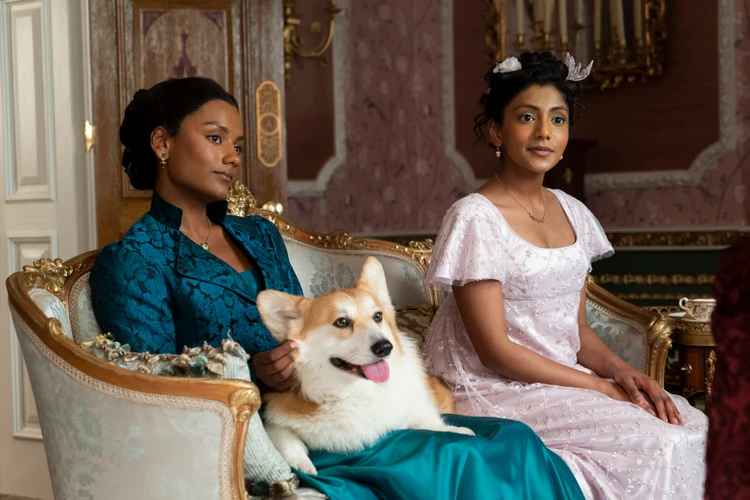South Asian representation in latest season of “Bridgerton”
April 21, 2022
The representation of South Asians in American media is filled with the same one-dimensional stereotypes: thick accents, existing as an outcast to White characters and smelling like curry. South Asian American children grew up watching Baljeet on the Disney Channel show “Phineas and Ferb,” the timid and weak Indian kid who was constantly bullied. They also watched Ravi in the hit Disney Channel show “Jessie,” who is the embodiment of the unathletic, awkward, belittled Indian character. Hollywood continues to be full of misrepresentations of South Asian culture and lackluster South Asian characters. However, this is beginning to change with the introduction of season two of the Netflix series “Bridgerton.”
“Bridgerton,” adapted from the novels by Julia Quinn, was first released on Dec. 25, 2020. The period drama depicts the lives of the eight Bridgerton siblings in 19th century London. The siblings maneuver through high-class London society, some in search of love during courting season. Quinn’s original novel is not inclusive of people of color, but the Netflix series decided to take a different approach with the inclusion of many characters of color. In Netflix’s press interview with Shonda Rhimes, the producer of “Bridgerton,” she explained that she wanted the historical period drama to be more representative of her audience.
“I wanted to feel like the world we were living in was as three-dimensional as possible, and I wanted to feel like the representation was as three-dimensional as possible, too,” Rhimes said.
In this season of Bridgerton, a new set of characters was introduced: Kate and Edwina Sharma, two Indian sisters. The Sharma sisters originally lived in Bombay, now Mumbai, India, and their delicate Indian accents are an indication of their background. “Bridgerton” subtly but elegantly includes candid South Asian traditions and rituals. In episode three, Kate is portrayed oiling her sister’s long black hair, a common Ayurvedic practice in South Asian culture done by an older relative. Episode six depicts a widely-practiced Hindu tradition, the Pasupu (in Telugu) or Haldi (in Hindi) ceremony. This ceremony is practiced before a bride gets married, where she is washed in a turmeric bath as a blessing to the new couple. During this scene, there is an ode to Bollywood through the string rendition of the tremendously popular Bollywood cover track song, “Khabi Kushi Khabie Gham.” This is not the only homage to Bollywood. One scene in episode six is parallel to the cinematography Bollywood is well known for: Kate Sharma dramatically drops her bangle, a bracelet worn by South Asians, in a slow-motion clip, referencing the dramatic styles of Bollywood cinematography.
A common practice in American media is to make South Asian women undesirable to the male gaze. In many of the few representations of South Asian women, if they are deemed desirable, it is a surprise. This is seen in the Netflix series, “Never Have I Ever” when Devi Vishwakumar, the main character of the series, surprisingly gets the attention of the hot jock, Paxton. In popular media, the concept that a brown girl could get the attention of a hot guy is almost an unimaginable concept.
“Bridgerton” counteracted this cliché by making South Asian women desirable to men without question. Edwina Sharma is named the “Diamond of the Season” by the Queen, or the most sought-after woman of the courting season. It does not come as a surprise that Edwina could be the most desirable woman in society. Her external and internal beauty is compelling. This is seen once again with the romance between Kate Sharma and Anthony Bridgerton. It is fun-loving and full of sexual tension, and the romance does not center on the fact that she is a brown woman. Anthony Bridgerton yearns for Kate because of her resilient personality, skillfulness and beauty.
Another victory by “Bridgerton” was the inclusion of a dark-skinned South Asian actress. Simone Ashley, who plays Kate Sharma, is a British-Indian actress. South Asian cultures, including India’s biggest Hindi cinema industry, struggle with colorism and hire only light-skinned actors. The inclusion of Ashley in “Bridgerton” is in opposition to this colorist tendency offering, a reminder that more dark-skinned South Asian actors must be further represented in Western and South Asian media.
However, “Bridgerton” also has a few misses. Language inconsistencies were the most prominent example. Kate and Edwina called their father “Appa,” the Tamil word for father, yet Edwina called her older sister “Didi,” the Hindi word for older sister. Once again, the last name Sharma is North Indian, yet they originally lived in the Southern region of India. These were frivolous mistakes that should have been more thoroughly researched. If South Asian characters are going to be represented in the media, further comprehensive research should be done.
Nonetheless, “Bridgerton” is an exciting example of representation for South Asians. This series may not be representative of all South Asian cultures, but it is encouraging to see South Asian characters finally not fall into media stereotypes. “Bridgerton” is an aesthetically beautiful show that is doing a worthwhile job at finally representing South Asian characters and culture gracefully and elegantly.












